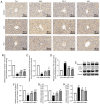Astragaloside IV alleviates liver injury in type 2 diabetes due to promotion of AMPK/mTOR‑mediated autophagy
- PMID: 33846768
- PMCID: PMC8060804
- DOI: 10.3892/mmr.2021.12076
Astragaloside IV alleviates liver injury in type 2 diabetes due to promotion of AMPK/mTOR‑mediated autophagy
Abstract
Diabetic liver injury is a serious complication of type 2 diabetes mellitus (T2DM), which is often irreversible in the later stage, and affects the quality of life. Autophagy serves an important role in the occurrence and development of diabetic liver injury. For example, it can improve insulin resistance (IR), dyslipidaemia, oxidative stress and inflammation. Astragaloside IV (AS‑IV) is a natural saponin isolated from the plant Astragalus membranaceus, which has comprehensive pharmacological effects, such as anti‑oxidation, anti‑inflammation and anti‑apoptosis properties, as well as can enhance immunity. However, whether AS‑IV can alleviate diabetic liver injury in T2DM and its underlying mechanisms remain unknown. The present study used high‑fat diets combined with low‑dose streptozotocin to induce a diabetic liver injury model in T2DM rats to investigate whether AS‑IV could alleviate diabetic liver injury and to identify its underlying mechanisms. The results demonstrated that AS‑IV treatment could restore changes in food intake, water intake, urine volume and body weight, as well as improve liver function and glucose homeostasis in T2DM rats. Moreover, AS‑IV treatment promoted suppressed autophagy in the liver of T2DM rats and improved IR, dyslipidaemia, oxidative stress and inflammation. In addition, AS‑IV activated adenosine monophosphate‑activated protein kinase (AMPK), which inhibited mTOR. Taken together, the present study suggested that AS‑IV alleviated diabetic liver injury in T2DM rats, and its mechanism may be associated with the promotion of AMPK/mTOR‑mediated autophagy, which further improved IR, dyslipidaemia, oxidative stress and inflammation. Thus, the regulation of autophagy may be an effective strategy to treat diabetic liver injury in T2DM.
Keywords: AS‑IV; diabetic liver injury; autophagy; AMPK; mTOR.
Conflict of interest statement
The authors declare that they have no competing interests.
Figures








Similar articles
-
Quercetin Ameliorates Myocardial Injury in Diabetic Rats by Regulating Autophagy and Apoptosis through AMPK/mTOR Signaling Pathway.Am J Chin Med. 2024;52(3):841-864. doi: 10.1142/S0192415X24500344. Epub 2024 May 8. Am J Chin Med. 2024. PMID: 38716618
-
Effect of vitamin D3 supplementation on hepatic lipid dysregulation associated with autophagy regulatory AMPK/Akt-mTOR signaling in type 2 diabetic mice.Exp Biol Med (Maywood). 2021 May;246(10):1139-1147. doi: 10.1177/1535370220987524. Epub 2021 Feb 4. Exp Biol Med (Maywood). 2021. PMID: 33541129 Free PMC article.
-
Astragalus polysaccharides alleviates glucose toxicity and restores glucose homeostasis in diabetic states via activation of AMPK.Acta Pharmacol Sin. 2009 Dec;30(12):1607-15. doi: 10.1038/aps.2009.168. Acta Pharmacol Sin. 2009. PMID: 19960007 Free PMC article.
-
Astragaloside IV derived from Astragalus membranaceus: A research review on the pharmacological effects.Adv Pharmacol. 2020;87:89-112. doi: 10.1016/bs.apha.2019.08.002. Epub 2019 Dec 18. Adv Pharmacol. 2020. PMID: 32089240 Review.
-
From Diabetes to Diabetic Complications: Role of Autophagy.Curr Med Sci. 2023 Jun;43(3):434-444. doi: 10.1007/s11596-023-2727-4. Epub 2023 Apr 28. Curr Med Sci. 2023. PMID: 37115396 Review.
Cited by
-
The role of autophagy in the treatment of type II diabetes and its complications: a review.Front Endocrinol (Lausanne). 2023 Sep 21;14:1228045. doi: 10.3389/fendo.2023.1228045. eCollection 2023. Front Endocrinol (Lausanne). 2023. PMID: 37810881 Free PMC article. Review.
-
Effects of Apilarnil on Type 2 Diabetes-Induced IRS-1/PI3K/Akt Mediated Insulin Resistance in Male Rats.ACS Omega. 2025 Jun 3;10(23):25027-25038. doi: 10.1021/acsomega.5c02662. eCollection 2025 Jun 17. ACS Omega. 2025. PMID: 40547654 Free PMC article.
-
The Potential of Naturally Derived Compounds for Treating Chronic Kidney Disease: A Review of Autophagy and Cellular Senescence.Int J Mol Sci. 2024 Dec 24;26(1):3. doi: 10.3390/ijms26010003. Int J Mol Sci. 2024. PMID: 39795863 Free PMC article. Review.
-
Ginsenoside Rg1 Ameliorates Pancreatic Injuries via the AMPK/mTOR Pathway in vivo and in vitro.Diabetes Metab Syndr Obes. 2023 Mar 15;16:779-794. doi: 10.2147/DMSO.S401642. eCollection 2023. Diabetes Metab Syndr Obes. 2023. PMID: 36945297 Free PMC article.
-
Could Cyclosiversioside F Serve as a Dietary Supplement to Prevent Obesity and Relevant Disorders?Int J Mol Sci. 2023 Sep 6;24(18):13762. doi: 10.3390/ijms241813762. Int J Mol Sci. 2023. PMID: 37762063 Free PMC article. Review.
References
-
- Tan SY, Mei Wong JL, Sim YJ, Wong SS, Mohamed Elhassan SA, Tan SH, Ling Lim GP, Rong Tay NW, Annan NC, Bhattamisra SK, Candasamy M. Type 1 and 2 diabetes mellitus: A review on current treatment approach and gene therapy as potential intervention. Diabetes Metab Syndr. 2019;13:364–372. doi: 10.1016/j.dsx.2018.10.008. - DOI - PubMed
-
- Shima T, Uto H, Ueki K, Takamura T, Kohgo Y, Kawata S, Yasui K, Park H, Nakamura N, Nakatou T, et al. Clinicopathological features of liver injury in patients with type 2 diabetes mellitus and comparative study of histologically proven nonalcoholic fatty liver diseases with or without type 2 diabetes mellitus. J Gastroenterol. 2013;48:515–525. doi: 10.1007/s00535-012-0653-5. - DOI - PubMed
MeSH terms
Substances
LinkOut - more resources
Full Text Sources
Other Literature Sources
Medical
Research Materials
Miscellaneous

